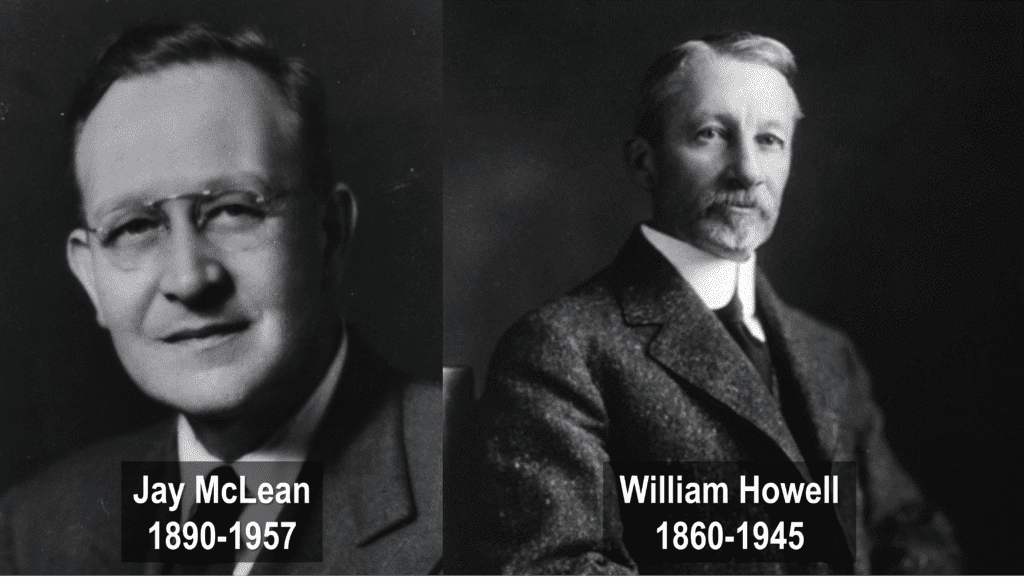Mostafa Elbaba
Doha, Qatar

The sulfated glycosaminoglycan known as heparin is the most common anticoagulant used in clinical medicine. Its therapeutic role is to increase antithrombin activity. While its physiologic role in humans is not fully understood, heparin is stored and secreted from mast cells at sites of tissue injury and is believed to provide local vascular defense against foreign agents. Pharmaceutically, heparin is derived from mucosal tissues of slaughtered meat animals such as the intestines of pigs or the lungs of cattle.
In 1916 Jay McLean, a second-year medical student at Johns Hopkins University, discovered heparin while studying clotting mechanisms under the guidance of Dr. William Howell. Assigned to examine the chemical purity and procoagulant activity of various cephalin preparations, McLean extracted from canine liver fat soluble phosphatides that had anticoagulant properties in vitro and caused excessive bleeding in experimental animals. His unexpected finding ultimately led to the isolation and purification of the substance they named “heparin,” derived from the Greek word “hepar,” meaning liver.
William Howell at the time was a professor of physiology at Johns Hopkins and author of the standard book of physiology for medical students. His main interest was studying substances that controlled blood clotting, and his research had centered on cephalin, which is released from the human brain. However, after McLean’s finding, he switched his interests to heparin.
In 1928 Charles Best, famous for his work on insulin, decided to develop heparin into something useful for research and clinical purposes. Along with a graduate student called Arthur Charles, he began work to further purify heparin, reduce or eliminate its side effects, and demonstrate its value in preventing thrombus formation.
At first heparin was available only in small amounts. It was very expensive and also toxic, and therefore of no medical value. It began to be studied in the early 1930s by Johan Erik Jorpes, the son of a poor Finnish fisherman who had moved to Sweden during the Finnish Civil War in 1918. Working at the Karolinska Institute in medical chemistry, he engaged in pioneering work on the isolation and structure of heparin. In 1935, he published the results of his research on the structure of heparin, and in 1936, he successfully purified heparin and subsequently demonstrated that it was localized in the mast cells of tissues. His work made it possible for the Swedish pharmaceutical company to launch the first heparin product for intravenous use in 1936.
It had at first been accepted that it was Howell who discovered heparin. However in the 1940s, Jay McLean became unhappy that he had not received appropriate recognition for what he saw as his own discovery. Though relatively discreet about his claim and not wanting to upset his former chief, he gave lectures and wrote letters claiming that the discovery was his. This gradually became accepted as fact, and indeed after his death in 1959, his obituary credited him as being the true discoverer of heparin. This was elegantly restated in 1963 in a plaque unveiled in Johns Hopkins to commemorate the major contribution (of McLean) to the discovery of heparin in 1916 in collaboration with Professor William Henry Howell.
Today, heparin continues to play a vital role in medical practice, serving as an indispensable tool in various clinical settings. Its remarkable journey, from serendipitous discoveries to life-saving therapies, stands as a testament to the power of scientific curiosity and perseverance.
References
- Barrowcliffe, T.W. “History of heparin.” Heparin-A Century of progress (2012): 3-22.
- Couch, Nathan P. “About heparin, or… whatever happened to Jay McLean?” Journal of vascular surgery 10, no. 1 (1989): 1-8.
- Fye, W. Bruce. “Heparin: the contributions of William Henry Howell.” Circulation 69, no. 6 (1984): 1198-1203.
- Hemker, H.C. “A century of heparin: past, present and future.” Journal of Thrombosis and Haemostasis 14, no. 12 (2016): 2329-2338.
- Marcum, James A. “William Henry Howell and Jay McLean: the experimental context for the discovery of heparin.” Perspectives in biology and medicine 33, no. 2 (1990): 214-230.
- Marcum, James A. “The origin of the dispute over the discovery of heparin.” Journal of the history of medicine and allied sciences 55, no. 1 (2000): 37-66.
- McLean, J.A.Y. “The discovery of heparin.” Circulation 19, no. 1 (1959): 75-78.
- Mutt, Viktor, and Margareta Blombäck. “Erik Jorpes—a pragmatic physiological chemist.” In Comprehensive biochemistry, vol. 41, pp. 363-389. Elsevier, 2000.
- Ong, Chin Siang, James A. Marcum, Kenton J. Zehr, and Duke E. Cameron. “A century of heparin.” The Annals of Thoracic Surgery 108, no. 3 (2019): 955-958.
- Shampo, Marc A., and Robert A. Kyle. “J. Erik Jorpes—Pioneer in the Identification and Clinical Applications of Heparin.” In Mayo Clinic Proceedings, vol. 72, no. 11, p. 1056. Elsevier, 1997.
- Singh, Devender. 100 Years of Heparin (1916-2016): Saga of Joys and Tears.” Indian Journal of Vascular & Endovascular Surgery vol. 3, no. 4: p 128-130, Oct–Dec 2016.
- Wardrop, Douglas, and David Keeling. “The story of the discovery of heparin and warfarin.” British journal of haematology 141, no. 6 (2008): 757-763.
- “Heparin.” Wikipedia. https://en.wikipedia.org/wiki/Heparin
MOSTAFA ELBABA is an Egyptian pediatric nephrologist. He received his master’s degree in medical education from Ain Shams University and has advanced certification in simulation. In 2011, he joined Hamad Medical Corporation in Qatar. Apart from medical qualification, he is a public writer certified in arts, the history of medicine, and religions.

Leave a Reply